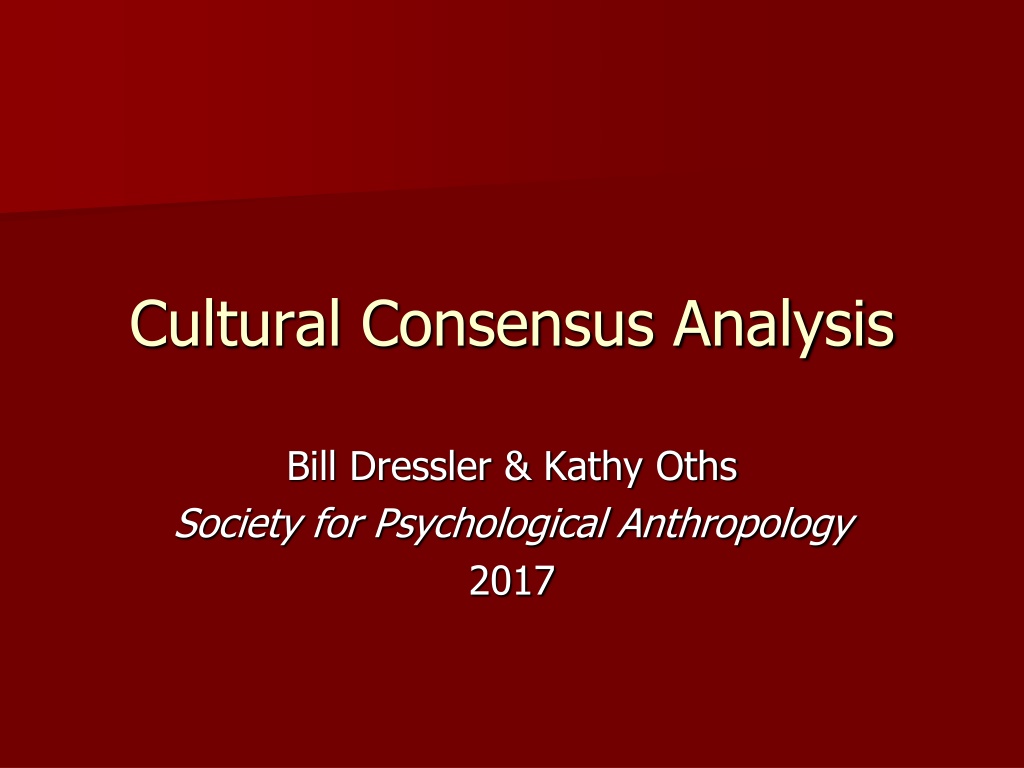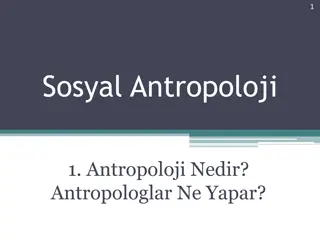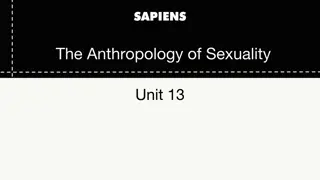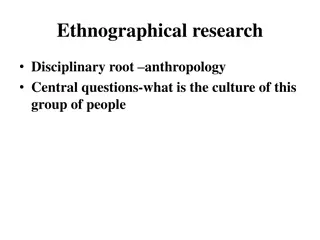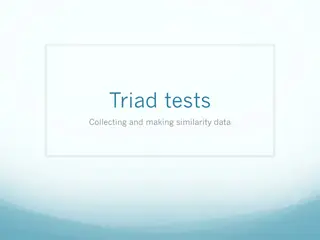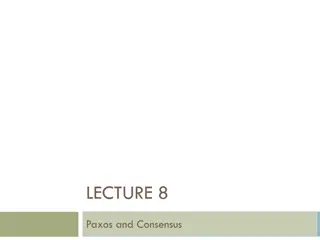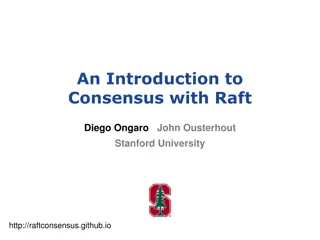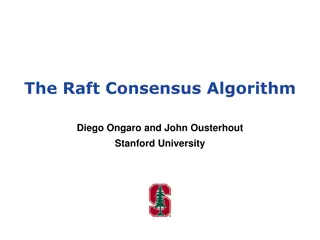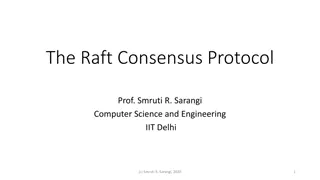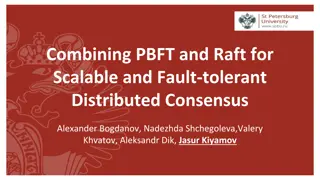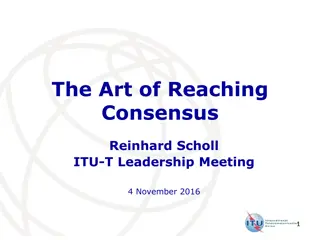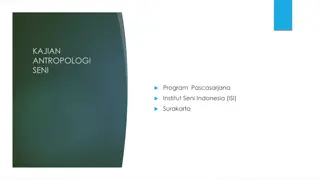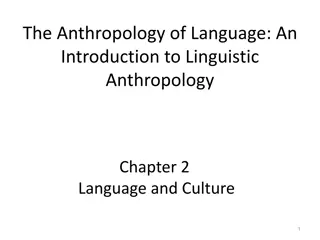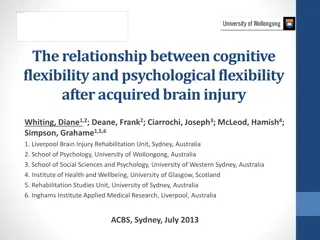Cultural Consensus Analysis in Psychological Anthropology
Explore the essence of Cultural Consensus Analysis (CCA) as a significant aspect of psychological anthropology. Through ethnographic work and structured techniques, CCA helps verify shared knowledge within cultural domains and enhance the comprehension of cultural models. The model and steps involved in studying cultural domains are outlined, emphasizing the importance of CCA in exploring cultural configurations and shared understanding.
Download Presentation

Please find below an Image/Link to download the presentation.
The content on the website is provided AS IS for your information and personal use only. It may not be sold, licensed, or shared on other websites without obtaining consent from the author.If you encounter any issues during the download, it is possible that the publisher has removed the file from their server.
You are allowed to download the files provided on this website for personal or commercial use, subject to the condition that they are used lawfully. All files are the property of their respective owners.
The content on the website is provided AS IS for your information and personal use only. It may not be sold, licensed, or shared on other websites without obtaining consent from the author.
E N D
Presentation Transcript
Cultural Consensus Analysis Bill Dressler & Kathy Oths Society for Psychological Anthropology 2017
Basic Outline of (very brief) Workshop Review basics of the model Quick overview of techniques Studying variation Cultural consonance
Steps in Studying Cultural Models Determine cultural domain to be studied Identify salient elements of the domain Free lists Open-ended interviews Explore the structure of the domain Pile sorts, ratings, rankings Narrative analysis Test for Cultural Consensus Explore distribution of cultural knowledge and content of shared understanding
Point to remember. Cultural consensus analysis is not the beginning Rather, it is the culmination of ethnographic work, usually supplemented by various forms of structured ethnographic techniques CCA then enables you to: Verify that knowledge is shared within a domain Explore and better understand the configuration of the cultural model(s)
The Cultural Consensus Model (Romney, Weller and Batchelder 1986) Responses of Individuals Determine R s relative degree of shared knowledge R1 R2 R3 R4 R5 R6 . . Rn Degree of sharing of knowledge Calculate a consensus set of responses, weighted by pattern of knowledge sharing
2-dimensional array of food similarities/differences: 2010 - 2014
Individual representation = [cultural model] + [personal model] What are the features that distinguish among the elements of the model? Is there a shared understanding of these features?
Pure personal biography: Adriane individual experiences with food .83 Adriane Greg individual experiences with food .83 Why? Shared cultural model: Greg Adriane knowledge1 Cultural Model of Food .83 Greg knowledge2 Individual correlation = knowledge1 x knowledge 2
Patterns of agreement: Meals Ratio indicates overall consensus, if > 3.0 Cultural competence coefficients indicate how well your answers reflect group-level answers Average cultural competence indicates the strength of the cultural consensus
Kim .95 Robin .98 Adriane .93 .98 Bryanna Cultural model of how to construct a meal .93 Kelso .92 Diedre .90 Alec .76 Heidi .78 .89 Joshua Greg
Consensus ratings of foods
Consensus ratings = a cultural best estimate How would a reasonably culturally competent member of this social group rate or classify these foods?
Fitting attributes to the array How do we know if people are using features to define semantic structures? Correlate the features with the distance between the points in the map of the pile sort If the correlation is high (> .75), then probably people were using those features to sort the terms
? Food Meal Health Southern TEA MASHP STEAK BURGERS SANWICH HOTDOG CORN CATFISH CHEESE APPLE FF COOKIE FCHICK RICE WING BEER ICREAM ORANGE SALAD PIE SHRIMP GRITS MNCHEES BEANS PEAS BBQ PIZZA BANANA OKRA TOMATO 4.00 2.00 1.00 1.00 1.00 1.00 2.00 1.00 4.00 5.00 2.00 3.00 1.00 2.00 1.00 4.00 3.00 5.00 2.00 3.00 1.00 2.00 2.00 2.00 2.00 1.00 1.00 5.00 2.00 4.00 1.76 2.64 2.71 1.77 2.76 1.49 3.48 3.06 2.71 3.93 1.21 1.06 1.31 3.16 1.49 1.51 1.17 4.00 3.76 1.27 3.58 2.64 1.85 3.68 3.79 1.87 1.65 3.82 3.78 3.82 4.00 3.86 3.47 3.31 2.66 2.38 3.84 3.76 3.56 2.58 2.94 2.69 3.97 3.08 2.78 3.25 2.85 1.80 2.63 3.88 3.23 4.00 3.67 3.63 3.32 3.90 2.06 2.03 3.87 3.46
Fitting the attributes Meal correlation = .91 Health correlation = .91 Southern correlation = .20
2-dimensional array of food similarities/differences: 2010 + 2011 Where does it go on my plate? Is it healthy?
Doing Cultural Consensus Analysis In Anthropac The formal process model The informal data model In a standard statistical package: SPSS Formal process model (MTTIW) Informal data model
Classic Brazilian Food Feij o/Feijoada Rice Churrasco Cerveja (beer) Macar o (pasta) Hearts of palm Pintado (catfish) Doces (sweets) Sucos/vitaminas Almo o (lunch) Launches Salgadinhos/picados Comida mineiro Comida baiano Comida carioca Comida ga cho
The Prestige Value of Food in Urban Brazil (Oths, Carolo, & dos Santos 2003) Sample Eigenvalue ratio Mean ( sd) Total sample 1.8:1 .40 ( .35) Upper-middle class 10:1 .69 ( .06) Middle class Single factor .54 ( .04) Lower middle class Single factor .81 ( .03) Lower class 1.8:1 .50 ( .28)
Testing variation with separate model estimates within groups (Oths, Carolo, & dos Santos 2003)
Cultural Modeling - The Domain of Family Life false 1.5 exploit selfish disrespect unfaithful violent addiction 1.0 irresponsibile bad manners fights Violence/addiction Lack of education .5 critical Importance for having a family 0.0 firm organized -.5 communication workers good relations happy help outgoing understanding union honest -1.0 religion love Family organization Affective climate -1.5 -.6 -.4 -.2 -.0 .2 .4
Distribution of Cultural Competence in Family Life urban Brazil Eigenvalue ratio = 8.49
Recommended cut-off points for the S.D. of cultural competence (Hruschka and Maupin 2013)
Relationship of years in Nairobi and cultural competence in the cultural model of HIV+ management (Copeland 2011) 0.9 0.85 CULTURAL OMPETENCE 0.8 0.75 0.7 0.65 0.6 0.55 0.5 0.45 0.4 < 5 yrs 5-9 yrs 10-19 yrs > 19 yrs YEARS IN NAIROBI
Cultural competence in family life and psychological distress in urban Brazil (n = 52) Step 1 -.073 -.163 -.343* Step 2 -.033 -.161 -.288* Step 3 .035 -.056 -.252* Age Sex Socioeconomic status Cultural competence in family life Cultural consonance in family life Multiple R - -.282* -.197* - - -.461* .378* .467* .635*
Residual Agreement Concept introduced by Boster in 1986 Refers to agreement among respondents beyond an overall cultural consensus Multicentric domain Defined by Caulkins and Hyatt Multicentric domains have multiple centers of agreement: Subcultural domains, in which there are two or more centers of agreement that are different but not oppositional Contested domains, in which some individuals take a perspective opposite to that expressed by others in the same population
Bosters (1986) original approach Works from the agreement matrix Run consensus analysis and then generate the predicted agreement Subtract the predicted agreement matrix from the observed agreement matrix to generate a residual agreement matrix Use QAP (quadratic assignment procedure) to test for correlation of the observed and residual agreement matrices If matrices are correlated, then there is residual agreement not exhausted by the consensus
Bosters original approach (cont.) This can be thought of as an omnibus test of residual agreement Just tells you it s there Not what it is Utility of this test may not be great, especially if there is always going to be some kind of residual agreement a reasonable assumption
Norbert Ross & Doug Medin In essence, they use the same approach as Boster to test for residual agreement They calculate residual matrices within groups and compare them Then, they identify which items from the consensus analysis differ between groups This actually confounds overall cultural consensus with whatever differences exist
Hruschka, et al. (2008) First, they confirm that there is an overall cultural consensus Second, using three different techniques, they demonstrate that there are different patterns of response within groups Third, they compare cultural answer keys calculated within groups Does not account for overall cultural consensus
Boster and Johnson (1989) Use the second factor This captures agreement left over after the overall consensus has been accounted for Plotting respondents by cultural competence coefficients and second factor loadings or residual agreement coefficients shows the shape of divergence from the overall consensus
Distribution of cases by cultural competence and residual agreement Eigenvalue ratio = 6.7 Mean competence = 0.70 s.d. = 0.11 (Second Factor) (First Factor)
Distribution of cases by cultural competence and residual agreement Blue = 2001 Red = 2011 p < .001 for residual agreement
Residual agreement (Dressler et al. 2015) Shared deviation from consensus within subgroup1 OVERALL CULTURAL CONSENSUS Residual agreement Shared deviation from consensus within subgroup2
Calculating deviation from the overall cultural consensus Dev1 = individual rating of item 1 consensus rating of item 1 Dev2 = individual rating of item 2 consensus rating of item 2 .. DevN = individual rating of item N consensus rating of item N Deviations averaged over individuals in subgroup1 Deviations averaged over individuals in subgroup2
compute d1 = ls1 - 3.07. compute d2 = ls2 - 3.23. compute d3 = ls3 - 1.64. compute d4 = ls4 - 3.02. compute d5 = ls5 - 3.9. compute d6 = ls6 - 2.6. compute d7 = ls7 - 3.30. compute d8 = ls8 - 3.92. compute d9 = ls9 - 2.06. compute d10 = ls10 - 3.11. compute d11 = ls11 - 3.84. compute d12 = ls12 - 3.6. compute d13 = ls13 - 2.96. compute d14 = ls14 - 2.57. compute d15 = ls15 - 3.3. compute d16 = ls16 - 3.82. compute d17 = ls17 - 2.38. compute d18 = ls18 - 2.78. compute d19 = ls19 - 2.04. compute d20 = ls20 - 3.34. compute d21 = ls21 - 1.91. compute d22 = ls22 - 3.88. compute d23 = ls23 - 2.14. compute d24 = ls24 - 3.77. compute d25 = ls25 - 2.84. compute d26 = ls26 - 3.65. compute d27 = ls27 - 2.6. compute d28 = ls28 - 2.56. compute d29 = ls29 - 2.45. compute d30 = ls30 - 3.65. compute d31 = ls31 - 3.66. compute d32 = ls32 - 2.73.
Results of the analysis of residual agreement internet 0.30 Items rated more important in 2011 < washmachine cellphone Mean deviations from the consensus answer key - 2011 0.20 listenmusic stereo microwave car read useinternet refigerator 0.10 sports church computer theater house rest study 0.00 stove tv lunchout converse -0.10 school movies parties telephone -0.20 watchtv Items rated more important in 2001 bar > shopping club furniture -0.30 -0.40 -0.30 -0.20 -0.10 0.00 0.10 0.20 Mean deviations from the consensus answer key - 2001
Respondents in 2011 rated as more important than the overall consensus items associated with information technologies, especially cell phones and internet access Items rated more important in 2011 internet 0.30 washmachine cellphone Mean deviations from the consensus answer key - 2011 0.20 listenmusic stereo microwave car read useinternet refigerator 0.10 sports church computer theater house rest study 0.00 stove tv Respondents in 2001 rated as more important than the overall consensus items associated with traditional Brazilian sociality, especially spending time in venues associated with social interaction lunchout converse -0.10 school movies parties telephone Items rated more important in 2001 -0.20 watchtv bar shopping club furniture -0.30 -0.40 -0.30 -0.20 -0.10 0.00 0.10 0.20 Mean deviations from the consensus answer key - 2001
